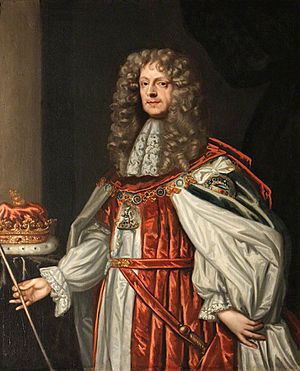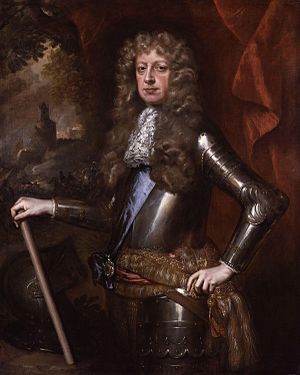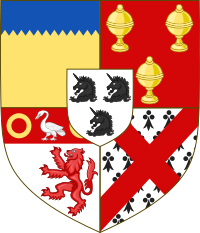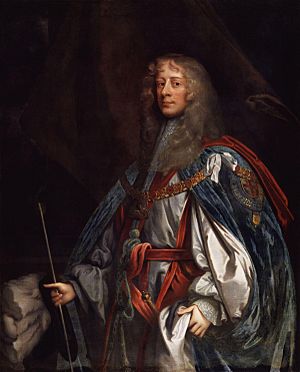James Butler, 1st Duke of Ormond facts for kids
Quick facts for kids
The Duke of Ormond
|
|
|---|---|

Portrait by Peter Lely
|
|
| Chancellor of the University of Oxford | |
| In office 4 August 1669 – 1688 |
|
| Preceded by | Gilbert Sheldon |
| Succeeded by | The 2nd Duke of Ormond |
| Lord High Steward | |
| In office 29 May 1660 – 13 February 1689 |
|
| Monarch | Charles II, James II |
| Preceded by | The 1st Duke of Richmond |
| Succeeded by | The 1st Duke of Devonshire |
| Lord Lieutenant of Ireland | |
| In office 24 May 1677 – 24 February 1685 |
|
| Monarch | Charles II |
| Preceded by | The 1st Earl of Essex |
| Succeeded by | The 2nd Earl of Clarendon |
| In office 21 February 1662 – 7 February 1668 |
|
| Monarch | Charles II |
| Preceded by | The 1st Duke of Albemarle |
| Succeeded by | The 6th Earl of Ossory |
| In office 30 September 1648 – 22 June 1649 |
|
| Monarch | Charles I |
| Preceded by | Viscount Lisle |
| Succeeded by | Oliver Cromwell |
| In office 13 November 1643 – 9 April 1646 |
|
| Monarch | Charles I |
| Preceded by | 2nd Earl of Leicester |
| Succeeded by | Viscount Lisle |
| Personal details | |
| Born | 19 October 1610 Clerkenwell, London, England |
| Died | 21 July 1688 (aged 77) Kingston Lacy, England |
| Resting place | Westminster Abbey, London |
| Spouse | Elizabeth Preston, Baroness Dingwall |
| Children | Thomas, Richard, Elizabeth, John, & others |
| Parents | Thomas, Viscount Thurles Elizabeth, Lady Thurles |
| Education | Trinity College |
| Military service | |
| Branch/service | |
| Years of service | 1639–1651 |
| Rank | Commander-in-chief, General, Commandant |
| Battles/wars | Wars of the Three Kingdoms (1639—1651) Second Bishops' War, 1st Siege of Drogheda, Battle of Kilrush, Battle of New Ross, Battle of Rathmines, 2nd Siege of Drogheda. |
James Butler, 1st Duke of Ormond (born October 19, 1610 – died July 21, 1688), was an important Anglo-Irish leader and soldier. He was known by different titles during his life: Earl of Ormond (1634–1642) and Marquess of Ormond (1642–1661). He became the Duke of Ormond in 1661.
James Butler was a key figure during a very difficult time in English and Irish history, especially during the Wars of the Three Kingdoms. He supported the King and played a big role in the conflicts in Ireland. After the King returned to power, Ormond became a major politician in both England and Ireland, holding many high positions.
Contents
Early Life and Family
James Butler was born in Clerkenwell, London, England, on October 19, 1610. He was the oldest son of Thomas Butler, Viscount Thurles and Elizabeth, Lady Thurles. His father was the heir to the Earl of Ormond title.
The Butler family was an "Old English" family in Ireland, meaning they were descendants of Normans who came to Ireland a long time ago. James's mother was English and Catholic.
A Difficult Childhood
Soon after James was born, his parents moved back to Ireland. In 1619, his father died in a shipwreck while traveling from Ireland to England. James then inherited his father's title, Viscount Thurles.
When James was nine, his mother sent him to a Catholic school in England. However, in 1623, King James I made James a ward of the Earl of Desmond. This meant the King decided who would look after James. He was placed with the Archbishop of Canterbury, George Abbot, to be raised as a Protestant. This was a big change because most of his family was Catholic.
Being raised Protestant was very important for James's future. It meant he was different from most of his relatives, who faced problems because of their Catholic faith. This caused some tension with his family.
When he was 15, James lived with his grandfather, the 11th Earl of Ormond, in London. His grandfather did not interfere with his Protestant education. James enjoyed court life and even started to learn Irish, which helped him later in his career.
Marriage and Children
In 1629, James fell in love with his cousin, Lady Elizabeth Butler (Preston). She was the only child and heir of the Earl of Desmond. They married on Christmas Day, 1629. This marriage helped to end a long-standing disagreement between their families and brought their large estates together, including Kilkenny Castle.
James and Elizabeth had eight sons and two daughters. Five of their children lived to be adults:
- Thomas (1634–1680): He died before his father, but his son became the 2nd Duke.
- Richard (1639–1686): He became the Earl of Arran.
- Elizabeth (1640–1665)
- John (1643–1677): He became the Earl of Gowran.
- Mary (1646–1710): She married William Cavendish, 1st Duke of Devonshire.
A Leader in Ireland
James Butler's career began in 1633 when Thomas Wentworth became the head of government in Ireland. Wentworth liked Ormond and helped him.
On February 24, 1633, James became the 12th Earl of Ormond after his grandfather died. He became a close friend and supporter of Wentworth. In 1635, he joined the Irish Privy Council, a group of advisors to the King.
Wentworth wanted to take land from Catholic owners to raise money for the King and reduce the power of Irish Catholic families. Ormond supported this, even though it angered his own Catholic relatives and led many of them to rebel.
In 1640, Ormond was made commander of the army in Ireland.
Fighting the Rebellion
When the Irish Rebellion of 1641 started, Ormond was in charge of the King's army in Dublin. Most of Ireland was taken over by Catholic rebels, including many of Ormond's relatives. However, his family ties were not completely broken; his wife and children were safely escorted from Kilkenny to Dublin by a rebel leader who was also a relative.
In early 1642, the Irish Catholics formed their own government, the Catholic Confederation, in Kilkenny. They started to build their own army. The King sent more troops from England and Scotland, and the Irish Confederate War began.
Ormond led several missions from Dublin in 1642. He cleared the area around Dublin of Confederate forces and helped supply royalist strongholds. He won the Battle of Kilrush against a larger force and was made Marquess of Ormond on August 30, 1642. The English Parliament thanked him and gave him a reward.
The Ormond Cessation
By March 1643, Ormond's troops were deep in Catholic territory, but the situation was difficult. The Confederates controlled two-thirds of Ireland. The English Civil War had started, meaning no more help would come from England. In fact, the King wanted his troops back. Also, Scottish and some Irish Protestant forces sided with the English Parliament against the King.
Stuck in Dublin, Ormond negotiated a "cessation" or ceasefire with the Confederates for a year, starting September 15, 1643. This agreement gave most of Ireland to the Catholic Confederation. This truce was strongly opposed by many Protestants in Ireland.
In November 1643, the King ordered Ormond to send his troops to England to fight for the Royalists in the Civil War. About 4,000 troops were sent. The King then made Ormond Lord Lieutenant of Ireland. Ormond's job was to stop the King's enemies (Parliamentarians) from getting help from Ireland and to send more troops to fight for the Royalists in England. He was also told to make a treaty with the Catholic Confederation so their troops could fight for the Royalists.
Peace Talks and Challenges
Ormond faced a tough challenge: he had to try and unite different groups in Ireland. The Irish Catholics wanted religious freedom and self-government in return for supporting King Charles I. But any agreement Ormond made with Catholics would make English and Scottish Protestants in Ireland less supportive of him.
In 1644, Ormond helped send an Irish Catholic force to Scotland to help the Scottish Royalists. This led to a civil war in Scotland.
In 1645, a treaty was signed between the King's representative and the Irish Catholics, but it was kept secret from Irish Protestants. When it became known, the opposition was so strong that King Charles had to cancel the treaty.
On March 28, 1646, Ormond signed another treaty with the Confederates, called the First Ormond Peace. This treaty offered religious concessions. However, the Catholic leaders rejected it, partly because of the Pope's ambassador, who didn't want them to compromise.
Ormond realized he couldn't hold Dublin against the Confederates. So, he made a deal with the English Parliament and handed Dublin over to them in June 1647. He said he "preferred English rebels to Irish ones." He then sailed to England.

Exile and Return to Ireland
Ormond stayed with King Charles in England for a while, but in March 1648, he went to Paris to avoid being arrested by Parliament.
In September 1648, he returned to Ireland, hoping to unite all groups for the King. The Irish Confederates were now more willing to compromise after losing many battles to the English Parliamentarians. On January 17, 1649, Ormond signed the Second Ormond Peace with the rebels, allowing them to practice their religion freely.
After King Charles I was executed, Ormond declared his loyalty to Charles II, who made him a Knight of the Garter. Ormond was put in charge of the Irish Confederate armies and English Royalist troops in Ireland.
However, despite controlling most of Ireland, Ormond could not stop Oliver Cromwell from conquering Ireland in 1649–1650. Ormond tried to retake Dublin but was defeated at the Battle of Rathmines in August 1649. He then tried to stop Cromwell by holding fortified towns, but Cromwell's army took them one by one.
Ormond lost most of his English and Protestant Royalist troops when they joined Cromwell in May 1650. This left him with only Irish Catholic forces, who did not trust him much. Ormond was removed from his command in late 1650.
Second Exile
Ormond left Ireland for France on December 7, 1650. He was very short on money but stayed close to Charles II and the Queen Mother in Paris. He traveled with the King to other cities when they were forced to leave France.
In 1658, Ormond secretly went to England in disguise to find out if there was a chance of an uprising to bring the King back. He was very active in the secret talks that led to the King's return.
Life After the King's Return
When Charles II returned to England as King in 1660, Ormond was given many important jobs. He became Lord Steward of the Household, a Privy Councillor, and was made Baron Butler and Earl of Brecknock in England. On March 30, 1661, he was made Duke of Ormond in Ireland and became Lord High Steward of England for Charles's coronation.
He also got back his huge estates in Ireland, and the King gave him large amounts of money to make up for what he had spent serving the Royal family. The Irish Parliament also gave him £30,000.
On November 4, 1661, he became the Lord Lieutenant of Ireland again. He worked hard to bring stability to the country, especially dealing with land issues. He strongly opposed a law that hurt Irish trade by banning the import of Irish cattle into England. He encouraged Irish manufacturing and learning.
Ormond was known for being dignified and loyal. He was proud of his service to the King, even when he lost royal favor. He said, "However ill I may stand at court I am resolved to lye well in the chronicle" (meaning he wanted to be remembered well in history).
Challenges and Attacks
Ormond faced attacks from some at court, especially from the Duke of Buckingham, who tried to reduce his influence. In March 1669, Ormond was removed from his role in governing Ireland. He didn't complain and continued his other duties. He was recognized for his service by being elected Chancellor of the University of Oxford on August 4, 1669.
In 1670, a man named Thomas Blood, who was known for other daring acts, tried to kidnap and assassinate Ormond. Ormond was pulled from his coach and taken on horseback, but he managed to escape. Many suspected that the Duke of Buckingham was behind this attack. The King's decision to pardon Blood and treat him kindly after he tried to steal the Crown Jewels made these suspicions stronger.
Ormond continued to work for Ireland's benefit. He helped establish the wool industry in Carrick-on-Suir in 1670. He also worked to protect the rights of Protestants in Ireland during a time of fear about Catholic plots.
In 1682, Charles II called Ormond to court. On November 29, 1682, he was given an English dukedom. In June 1684, he returned to Ireland but was called back to London in October due to new political problems. Before he could hand over his government, Charles II died. Ormond's last act as Lord Lieutenant was to announce James II as the new King in Dublin.
Ormond also served as the Chancellor of Trinity College, Dublin, from 1645 to 1688.
He spent his last years in retirement. He died on July 21, 1688, at Kingston Lacy estate in Dorset, England. He was buried in Westminster Abbey on August 4, 1688. His eldest son, Thomas, had died before him, so Thomas's son, James, became the 2nd Duke of Ormond.
| Timeline | ||
|---|---|---|
| Age | Date | Event |
| 0 | 1610, 19 Oct | Born at Clerkenwell, London |
| 9 | 1619, 15 Dec | Father drowned at sea. James became heir apparent as Viscount Thurles. |
| 12 | 1623, 26 May | Made a ward of the Earl of Desmond, by order of the King |
| 14 | 1625, 27 Mar | Accession of King Charles I, succeeding King James I |
| 19 | 1629, 25 Dec | Married Elizabeth Preston |
| 22 | 1633, 24 Feb | Succeeded his grandfather as the 12th Earl of Ormond]]. |
| 31 | 1642, 15 Apr | Defeated the Confederates under Mountgarrett at the skirmish of Kilrush. |
| 31 | 1642, 30 Aug | Created Marquess of Ormond. |
| 32 | 1643, 15 Sep | Signed the Cessation (truce) he had negotiated with the Confederates. |
| 33 | 1643, Nov | Appointed Lord Lieutenant of Ireland |
| 35 | 1645, 21 Oct | Giovanni Battista Rinuccini, the papal nuncio, landed in Ireland. |
| 35 | 1646, 28 Mar | Signed 1st Ormond Peace with the confederates, but it was never ratified. |
| 36 | 1647, 28 Jul | Left for England. |
| 37 | 1648, Feb | Escaped from London to France. |
| 37 | 1648, 29 Sep | Returned to Ireland landing at Cork |
| 38 | 1649, 17 Jan | Signed the 2nd Ormond Peace with the Confederates |
| 38 | 1649, 30 Jan | King Charles I assassinated. |
| 38 | 1649, 23 Feb | The papal nuncio Giovanni Battista Rinuccini left Ireland. |
| 38 | 1649, Aug | Lost the Battle of Rathmines against the Parliamentarians under Michael Jones |
| 38 | 1649, Sep | Made a Knight of the Garter |
| 40 | 1650, 11 Dec | Left Ireland, sailing on the frigate Elizabeth from Gleninagh Castle in the Bay of Galway |
| 49 | 1660, 29 May | Restoration of King Charles II |
| 50 | 1661, 30 Mar | Created Duke of Ormond in the Irish Peerage |
| 51 | 1661, 4 Nov | Appointed Lord Lieutenant of Ireland |
| 69 | 1680, 30 Jul | Son Thomas, Earl of Ossory, died. |
| 74 | 1685, 6 Feb | Accession of King James II, succeeding King Charles II |
| 77 | 1688, 21 Jul | Died at Kingston Lacy estate, Dorset, England |
Images for kids
See also
 In Spanish: James Butler, I duque de Ormonde para niños
In Spanish: James Butler, I duque de Ormonde para niños




